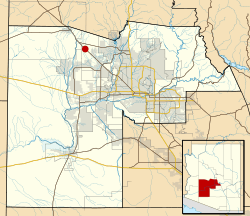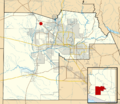Circle City, Arizona facts for kids
Quick facts for kids
Circle City, Arizona
|
|
|---|---|

Location in Maricopa County, Arizona
|
|
| Country | United States |
| State | Arizona |
| County | Maricopa |
| Elevation | 1,864 ft (568 m) |
| Population
(2020)
|
|
| • Total | 522 |
| Time zone | UTC-7 (Mountain (MST)) |
| ZIP code |
85342 (Morristown)
|
| FIPS code | 04-13610 |
| GNIS feature ID | 2805213 |
Circle City is a small community located in Maricopa County, Arizona. It is about 17 miles northwest of a town called Surprise. You can find it right on U.S. Route 60.
In 2020, about 522 people lived in Circle City. It is known as a "census-designated place" or CDP. This means it's a special kind of community that the government counts for population. However, it is not officially a city or town with its own local government.
Contents
Discovering Circle City
Circle City is a quiet place in the desert landscape of Arizona. It sits at an elevation of 1,864 feet above sea level. The community uses the 85342 ZIP code, which is shared with nearby Morristown.
The area experiences the Mountain Standard Time (MST). This means it is seven hours behind Coordinated Universal Time (UTC-7).
What is a Census-Designated Place?
A census-designated place, or CDP, is a special area defined by the United States Census Bureau. It is like a town or village but does not have its own local government. CDPs are created for statistical reasons. This helps the government collect and share information about population and housing.
People living in a CDP are often part of a larger county. They receive services from the county government. This is different from a city or town, which usually has its own mayor and city council.
History of Circle City
Circle City was built in the late 1950s. It was created by a group called The Workmen's Circle. This group was a Jewish organization that helped its members. They focused on supporting each other and their communities.
The Workmen's Circle built Circle City as a retirement community. It was a place for their older members to live. The group had a history of working for social fairness and helping people. They believed in creating strong communities where everyone could support each other.
The idea was to create a peaceful place for people to enjoy their later years. It was a community built on shared values and mutual support.
Images for kids


